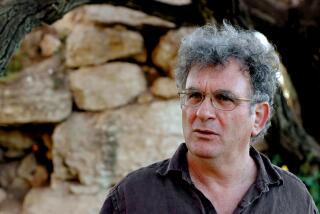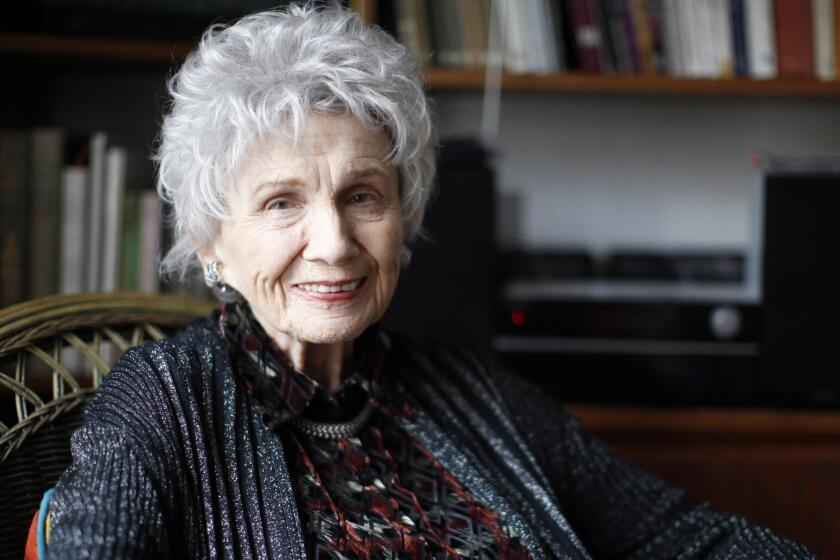He She We : Reading Stonewall
In Robb Forman Dew’s “The Family Heart: A Memoir of When Our Son Came Out” (Addison Wesley) the novelist and her professor husband are surprised and not a little embarrassed by their own lack of knowledge about what being gay is all about. Although they counted lesbians and gay men among their friends and believed themselves unprejudiced against gay people, they found their son’s coming out not only a shock to their family’s emotional system, but to their own knowledge of the world. Nobody reading this remarkable and affecting book will forget the images of confusion--the novelist’s thought that they should pack up and move to San Francisco, the two parents in bed in that revelatory summer, he planning railroad trips they did not intend to take, she stringing enough popcorn decorations for a dozen Christmas trees. As Robb Forman Dew found out, we are in your lives and yet you don’t really know much about us. That self-imposed ignorance is not benign but consequential.
The 25th anniversary of Stonewall is an ideal occasion for readers to remedy their own lack of information. The little rebellion at a gay bar in Greenwich Village, where the bar’s patrons, many of them drag queens an other “disreputable” types, resisted routine police repression, was not the first time gays fought back, nor were gay bars the only places where gays and lesbians resisted society’s repression. What made Stonewall a turning point was that its resistance spread to the streets, and subsequent spread of that from there into the public mind.
While some might question Stonewall’s status as a revolutionary event, few would question its significance as a cultural event. Whatever else it signaled, Stonewall symbolizes the emergence of an openly lesbian and gay public literary culture. Lesbian and gay committees of correspondence fueled the consciousness of the movements for homosexual liberation. It was through literature (Melville, Wilde, Whitman and Stein, as well as that literature locked in library stacks or under the counters of newsstands) that significant numbers of gays began to understand themselves and one another and construct the secret histories that have sustained them. To read was the way gays could try making sense of feelings the culture in general still insists that they ignore, deny and change.
To write, as it happens, was an equal imperative. There has always been a special affinity of lesbians and gay men for the work of culture. Some have seen this as the gay “office” in society. But gay writing was itself a danger. It was his letters that convicted Oscar Wilde, and the necessity for literary codes, pseudonyms and the resources of the samidzat characterized pre-Stonewall gay writing. Stonewall 25 reminds us of the vital and voluminous writing and publishing about lesbian and gay lives and concerns, not only by the small gay presses and feminist presses that have always sustained lesbian and gay writing but by the university and commercial presses that have come to recognize the large readership for works by and about gays, as the publishers of the titles discussed below indicate.
The development of a lesbian and gay scholarship from all disciplines and quarters, not just the university (and not only from gay individuals) has been a striking post-Stonewall development. George Chauncey’s “Gay New York: Gender, Urban Culture and the Making of the Gay Male World 1890-1940” (Basic Books) is a landmark gay history of the city that hosted the largest and most various gay life, not to mention the Stonewall incident itself (which Chauncey’s projected second volume will cover) and with Los Angeles and San Francisco cradled the gay movement. Chauncey argues that the very phenomenon of Stonewall and the contemporary lesbian and gay liberation movement have made us blind to the size and variety of gay life before World War II. He identifies three myths of gay life, that gays were isolated, that gays were invisible and that they internalized society’s prejudices against them.
Chauncey’s study of the great metropolis interestingly complements “Boots of Leather, Slippers of Gold” (Routledge) Elizabeth Lapovsky Kennedy’s and Madeline D. Davis’s history of the lesbian working class community in Buffalo. Drawing on oral history as well as records, the authors have represented a microcosmic study of a fascinating and vital community. The importance of class and race and the techniques of survival in the face of oppression marked the historical experience of these women. Kennedy and Davis have written about the specific local development of a consciousness of kind that is required for a liberations movement and that they show existed before Stonewall in Buffalo.
The Buffalo lesbian community is the setting for one of the year’s most powerful novels, “Stone Butch Blues” (Firebrand Books) by Leslie Feinberg. This extraordinary story of Jess, a he-she growing up in a blue collar city in the 1950s, coming out into factories and gay bars in the early ‘60s and deciding to pass as a man in order to survive, recaptures the essential experience of the lesbian (or gay man) whose nature is perceived by society as somehow unnatural. The coincidence of these two explorations of lesbian experience in the same city and the same historical period is itself an important marker. Kennedy and Davis, for instance, show how the “cleaning up” of the Buffalo police in the early ‘60s had the effect of making the lesbian community more vulnerable to police repression, a repression Feinberg’s Jess experiences unforgettably in “Stone Butch Blues.”
A key function of gay studies has been to recover the gay cultural past. No serious readers can doubt any more that the gay sexual orientation of Walt Whitman or Henry James, Gertrude Stein or Willa Cather, of Cole Porter or Countee Cullen, etc., played a significant part in their lives and (in most cases) in their work; the discussion has profitably been shifted to how and where sexual orientation, like race, gender and reading, is reflected in art. Whitman, for instance, has been shown by such scholars as Michael Moon (“Disseminating Whitman,” Harvard University Press) to have been guided by a variety of concerns related to what we would call his sexual orientation in the revision of “Leaves of Grass.” Gay and lesbian studies have been the occasion for powerful reconsiderations of the traditions of western literary and cultural expression. Eve Kosofsky Sedgwick’s collection of essays, “Tendencies” (Duke University Press) continues her excavation of what lies at the heart of western culture and gives a virtuosic example of how contemporary theory can discover new worlds in the familiar.
A striking example of lesbian and gay scholarly activism is a new anthology of “The New Gay and Lesbian Musicology” edited by Philip Brett, Elizabeth Wood and Gary C. Thomas. The essays in “Queering the Pitch” (Routledge) take all manner of approaches to discover what being lesbian and gay has to do with being musical an old code word for being homosexual. Thomas’ “Was George Frederick Handel Gay: On Closet Questions and Cultural Politics” and Susan McClary’s “Constitution of Subjectivity in Schubert’s Music” show how the question of a composer’s homosexuality forms an essential part in understanding the music. Phillip Brett’s essay on “Eros and Orientalism in Britten’s Operas” and his powerful essay “Music Essentialism, and the Closet” define the challenge that this particular collection and the gay studies impulse in general present to cultural complacency and how much we all have to gain as listeners, readers and people from it.
The most controversial example of gay scholarship of the moment is the extraordinary book by historian John Boswell, “Same Sex Unions in PreModern Europe” (Villard Books). Boswell’s research has yielded the texts of liturgies from medieval Europe that he believes indicate church solemnizing of “the same-sex equivalent of a medieval heterosexual marriage ceremony (though not necessarily a precise equivalent of its modern descendants.)” His book is meticulous, evidence based, well written and above all scholarly. Boswell makes the texts he has discovered available to the reader in a detailed context that not only supports his own interpretation but gives the attentive reader grounds to make an independent judgment. The heated response to news of the book shows how resistant many people still are to the possibility that history might subvert contemporary prejudice.
Reading Stonewall means also reading the novels, plays, poems, autobiographies and essays that abound in contemporary literature. AIDS has been the occasion of an extraordinary amount of important writing, the occasion of great suffering, tremendous losses to the literary community and of striking creativity that can only be suggested here. Terry Wolverton’s “Blood Whispers: LA Writers on AIDS Vol. 2” (Silverton Books, The Los Angeles Gay and Lesbian Community Services Center) includes such writers as Luis Alfaro, Eloise Klein Healy, James Carroll Pickett, David Vernon and Ms. Wolverton herself. Paul Monette’s new collection, “Last Watch of the Night” (Harcourt Brace) continues this talented and perceptive writer’s reports from the front in a world that AIDS has transformed.
Last year Wayne Kostenbaum’s extraordinary “The Queens Throat: Opera, Homosexuality and the Mystery of Desire” (Vintage) refashioned the traditional gay male partiality for the opera, and especially its divas, into an amazing book. His new book of poetry, “Rhapsodies of a Repeat Offender” (Persea) continues his passion, in common with that of other lesbian and gay writers, to express in new forms and especially in a free and open way, passions and interests that had been coded before. Kostenbaum’s poems signify the replacement of hitherto secret codes with something more than telling the secrets, with literature. He refigures the gay response to its icons in post Stonewall terms: “Once, Garbo was whispering secrets of performance/in a bandaged voice, and I was listening, and no toxins in the field/of vision arose to violate the soliloquy, unfolding/with the tranquility of all final compositions.”
In her new book, lesbian novelist Katherine Forest addresses another sustaining imperative of Stonewall writing. “Flashpoint” (Naiad) is a political novel in the honorable tradition of American political writing. Several lesbian and gay friends gather at a mountain cabin in anticipation of Governor Pete Wilson’s shabby veto in 1991 of a gay rights bill he had promised to sign. In the course of this honest and resonant book the stories of lesbian and gay life in America, the intertwining of survival skills with the horror of what made living into surviving, become the focus of individuality and community, sharing and dispute. Like Stonewall itself, as a historical event, a commemorative celebration and now a literary event, “Flashpoint” understands and insists that it is in relation to freedom and to coming out that lesbian and gay people define themselves. It is in this sense above all that Stonewall resonates and probably always will.
More to Read
Sign up for our Book Club newsletter
Get the latest news, events and more from the Los Angeles Times Book Club, and help us get L.A. reading and talking.
You may occasionally receive promotional content from the Los Angeles Times.






